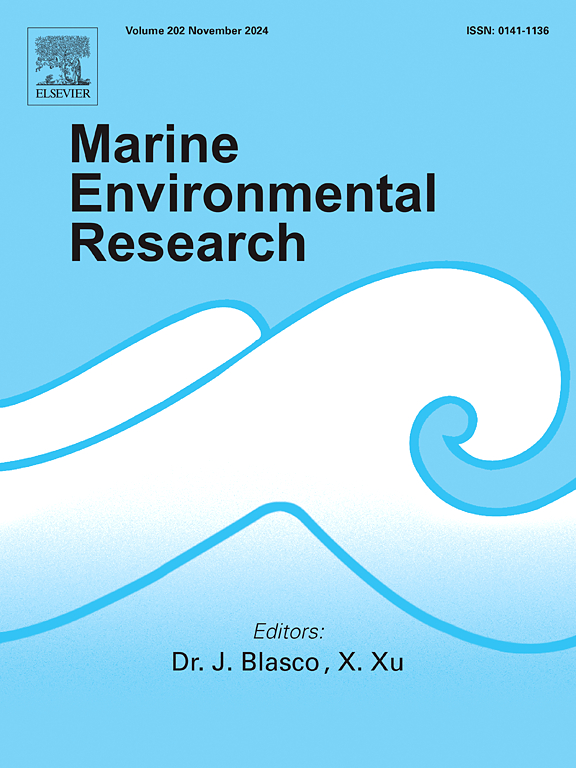Biomagnification of per-and polyfluoroalkyl substances in aquatic food species from a tropical lagoon ecosystem
IF 3
3区 环境科学与生态学
Q2 ENVIRONMENTAL SCIENCES
引用次数: 0
Abstract
We investigated the occurrence, species-specific distribution, accumulation, and biomagnification of poly- and perfluoroalkyl substances (PFAS) in three teleost fish species (Sarotherodon melanotheron, Clarias gariepinus, and Chrysicthys nigrodigitatus), as well as molluscs (Pachymelania aurita), earthworms (Lumbricus terrestris), and sediment samples from the Ologe Lagoon in Nigeria, which receives complex mixtures of anthropogenic effluents from various sources. Total ∑PFAS concentrations (ng/g) were significantly highest in earthworms (16.2), compared to teleost species (S. melanotheron (1.8), C. gariepinus (1.2), and C. nigrodigitatus (1.8)) and molluscs (0.4). The novel precursor diSAMPAP was the dominant PFAS congener in S. melanotheron and C. gariepinus, while PFOS and diSAMPAP were highest in C. nigrodigitatus. In earthworms, molluscs, and sediment, diSAMPAP, PFBS, and PFOS were the dominant PFAS. We calculated the biota sediment accumulation factor (BSAF), revealing that diSAMPAP in S. melanotheron and 8:2 FTS in earthworms exhibited the highest BSAF values. Species-specific differences in PFAS biomagnification factor (BMF) suggest varying exposure routes among the examined fish species. Notably, PFOS concentrations in the liver were significantly higher than in flesh tissues for C. gariepinus and C. nigrodigitatus, indicating organ-specific accumulation. Risk analysis using the Risk21 tool showed that S. melanotheron had the highest public health risk, while C. gariepinus had the least risk. Our results highlight significant food safety concerns and public health risks associated with the occurrence, species-specific distribution, accumulation, and biomagnification of diSAMPAP, 8:2 FTS, and PFOS in the Ologe Lagoon and its aquatic food webs. This study contributes valuable insights to global PFAS monitoring efforts, particularly in fluvial tropical ecosystems such as those found in Nigeria.

热带泻湖生态系统中水生食物中全氟烷基和多氟烷基物质的生物放大效应
我们调查了三种硬骨鱼类(Sarotherodon melanotheron、Clarias gariepinus和Chrysicthys nigrodigitatus)、软体动物(Pachymelania aurita)、蚯蚓(Lumbricus terrestris)以及尼日利亚loge泻湖沉积物样本中多氟烷基和全氟烷基物质(PFAS)的发生、物种特异性分布、积累和生物放大情况。总∑PFAS浓度(ng/g)在蚯蚓中最高(16.2),其次是硬骨鱼(S. melanotheron)(1.8)、C. gariepinus(1.2)和C. nigrodigitatus(1.8)和软体动物(0.4)。新前体diSAMPAP在黑黑的S. melanotheron和C. gariepinus中是显性的PFAS同系物,而在黑黑的C. nigrodigitatus中PFOS和diSAMPAP含量最高。在蚯蚓、软体动物和沉积物中,diSAMPAP、PFBS和PFOS是主要的PFAS。结果表明,黑松的diSAMPAP和蚯蚓的8:2 FTS的BSAF值最高。PFAS生物放大因子(BMF)的物种特异性差异表明在所检查的鱼类中存在不同的暴露途径。值得注意的是,肝脏中的全氟辛烷磺酸浓度显著高于肉组织,表明器官特异性积累。使用Risk21工具进行风险分析显示,S. melanotheron的公共卫生风险最高,C. gariepinus的公共卫生风险最低。我们的研究结果强调了与Ologe泻湖及其水生食物网中diSAMPAP、8:2 FTS和PFOS的发生、物种特异性分布、积累和生物放大相关的重大食品安全问题和公共卫生风险。这项研究为全球PFAS监测工作提供了有价值的见解,特别是在尼日利亚等热带河流生态系统中。
本文章由计算机程序翻译,如有差异,请以英文原文为准。
求助全文
约1分钟内获得全文
求助全文
来源期刊

Marine environmental research
环境科学-毒理学
CiteScore
5.90
自引率
3.00%
发文量
217
审稿时长
46 days
期刊介绍:
Marine Environmental Research publishes original research papers on chemical, physical, and biological interactions in the oceans and coastal waters. The journal serves as a forum for new information on biology, chemistry, and toxicology and syntheses that advance understanding of marine environmental processes.
Submission of multidisciplinary studies is encouraged. Studies that utilize experimental approaches to clarify the roles of anthropogenic and natural causes of changes in marine ecosystems are especially welcome, as are those studies that represent new developments of a theoretical or conceptual aspect of marine science. All papers published in this journal are reviewed by qualified peers prior to acceptance and publication. Examples of topics considered to be appropriate for the journal include, but are not limited to, the following:
– The extent, persistence, and consequences of change and the recovery from such change in natural marine systems
– The biochemical, physiological, and ecological consequences of contaminants to marine organisms and ecosystems
– The biogeochemistry of naturally occurring and anthropogenic substances
– Models that describe and predict the above processes
– Monitoring studies, to the extent that their results provide new information on functional processes
– Methodological papers describing improved quantitative techniques for the marine sciences.
 求助内容:
求助内容: 应助结果提醒方式:
应助结果提醒方式:


